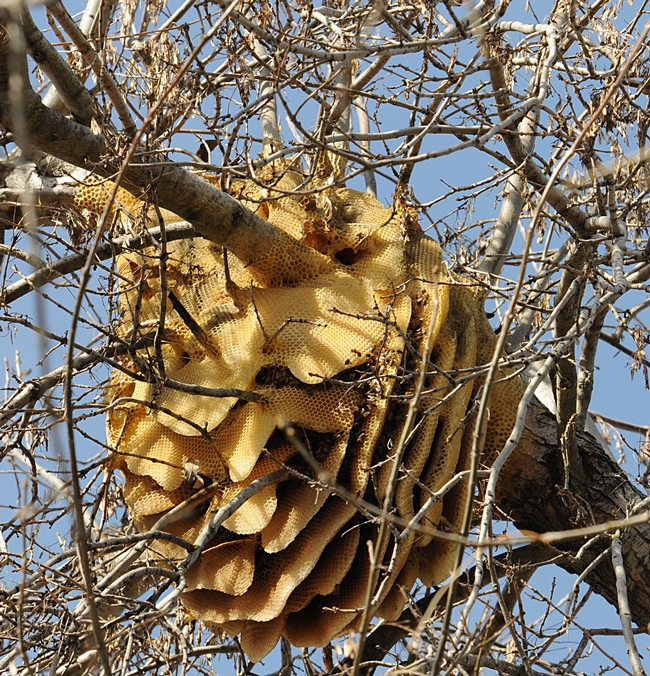Dec 30, 2011
As 2012 approaches, it's "out with the old and in with the new!"
Not always.
The huge feral honey bee colony that we photographed Jan. 9, 2011 in a Modesto ash tree at a Vacaville (Solano County), backyard, is still going strong. Thirty feet off the ground, the structure is solidly intertwined in the limbs of the old tree and is truly a sight to bee-hold.
Bee scientists at the Harry H. Laidlaw Jr. Honey Bee Research Facility, UC Davis, estimate it's been there since the spring of 2010. Leaves shroud it much of the year, but when the leaves drop, it's very much exposed.
Despite heavy rains, severe winds, robber bees, and foraging birds and other animals, this feral bee colony stays put.
On Sunday, Jan. 1, it will enter its third year of existence, which is quite remarkable in itself. Several UC Davis bee experts figured it wouldn't make it through the 2010-2011 winter. "If it lasts, I want that queen!" bee breeder-geneticist Susan Cobey quipped.
Well, it's lasted. And we're now in the second winter.
The homeowner just told us that "Yes, the feral bee colony is still there! Now that most of the leaves have blown off the tree, so it's much easier to see. The bees still come down to the deck to walk, not fly around. I'm surprised that it's remained viable for so long. The bees still buzz busily around the structure! What an amazing natural phenomenon!"
The huge feral honey bee colony that we photographed Jan. 9, 2011 in a Modesto ash tree at a Vacaville (Solano County), backyard, is still going strong. Thirty feet off the ground, the structure is solidly intertwined in the limbs of the old tree and is truly a sight to bee-hold.
Bee scientists at the Harry H. Laidlaw Jr. Honey Bee Research Facility, UC Davis, estimate it's been there since the spring of 2010. Leaves shroud it much of the year, but when the leaves drop, it's very much exposed.
Despite heavy rains, severe winds, robber bees, and foraging birds and other animals, this feral bee colony stays put.
On Sunday, Jan. 1, it will enter its third year of existence, which is quite remarkable in itself. Several UC Davis bee experts figured it wouldn't make it through the 2010-2011 winter. "If it lasts, I want that queen!" bee breeder-geneticist Susan Cobey quipped.
Well, it's lasted. And we're now in the second winter.
The homeowner just told us that "Yes, the feral bee colony is still there! Now that most of the leaves have blown off the tree, so it's much easier to see. The bees still come down to the deck to walk, not fly around. I'm surprised that it's remained viable for so long. The bees still buzz busily around the structure! What an amazing natural phenomenon!"
The photo (below) of the feral honey bee colony that first appeared in Bug Squad has attracted a lot of attention. A TV producer asked to borrow it for a recent episode of My Extreme Animal Phobia (Animal Planet), about a guy deathly afraid of honey bees. If you saw the entire episode--some of it filmed at the Laidlaw facility and some of it filmed in the quarters where a Sacramento clinical psychologist was treating him--you saw the photo on a bedroom wall.
We don't know how this magnificent structure could instill fear. For us, it instills only wonder, amazement and admiration.
Topics:
Attached Images:

Feral honey bee colony in a Modesto ash tree in Vacaville is still going strong. On Sunday, it will enter its third year of existence. (Photo by Kathy Keatley Garvey)